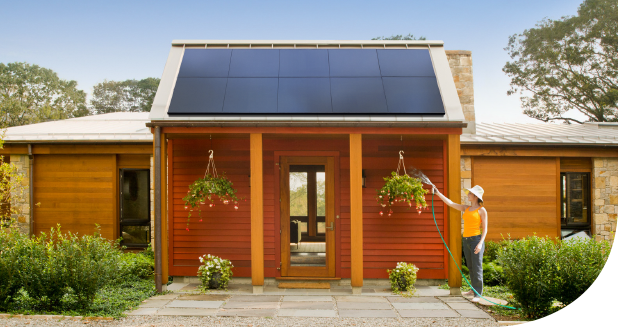
(photo from solar.sunpower.com)
Our town of Vienna VA is currently participating in a program called Solarize Vienna. It’s an innovative program that allows folks to put solar panels on their homes, at a reduced price (due to a group purchase), installed by local companies. The households that participate are also eligible for a federal tax deduction!

Since we’re paying a lot of attention to solar around here these days, we noticed this editorial from the Roanoke Times – lots of interesting information about solar power!
Our view: Some amazing facts
Posted: Sunday, May 17, 2015 2:15 am
The world is full of amazing facts.
Here’s one of them:
There are now more solar energy installers in the country than there are coal miners — 97,000 compared to 80,396.
Whether that’s a good thing or a bad thing depends, in part, on how you feel about coal.
Another amazing fact: Coal production in the U.S. is actually not far from its historic high, which came in 2008 when the nation’s coalfields were made 1.17 billion tons lighter.
Whether you want to blame or credit the decline on coal-mining since then on the Obama administration and its “war on coal” (which, admittedly, is a sexier slogan than “war on carbon emissions”) or the economy or other factors, take your pick.
Still, there’s this: The 97 million tons of coal mined in the U.S. last year means coal production has dropped to levels not seen since . . . 1994. If coal production drops further, then coal under Obama might fall to where it was during, say, the Reagan administration.
If you’re concerned about carbon emissions, this might indeed be “the moment when the rise of the oceans began to slow and our planet began to heal,” as Barack Obama so grandly put it back during his 2008 campaign.
Context: Even though coal production is up 40 percent from where it stood at the end of World War II, the number of miners required to produce that coal is down, way down.
In fact, the number of coal miners in the U.S. peaked in 1920 and has been going down in fits and starts ever since as technology has made the job less labor-intensive. From 725,030 miners then to 80,396 now, according to the Department of Energy. (That’s still a bit higher than the historic low of 71,552 in 2000, but there’s no mistaking the general direction of the trend line.)
In Virginia, the employment commission tells us we now have only about 3,500 coal miners left — or fewer than work in the Roanoke Valley school systems. Or, if you prefer, about double the 1,800 people estimated to be working in the solar energy field in Virginia.
Yet we still refer to the six counties in Virginia’s southwestern tip as “coal counties,” and politicians will spend much time this fall decrying the “war on coal.” True, looking just at miners is a narrow view of the impact of the coal industry. Those figures don’t count, for instance, the railroad workers who haul the black stuff to port. We don’t see trainloads of sunshine rumbling through Roanoke, so that’s one reason why coal has the political impact it does and solar sometimes still gets laughed at.
When Obama recently announced a program to train returning military veterans to work in the solar energy field, the conservative Daily Caller jeered: “This Is How Obama Is Going To Reward Veterans . . . With Solar Industry Jobs.”
Actually, that’s not a bad idea. Solar energy is a growth industry. Forbes says the number of solar jobs has increased by 20 percent two years in a row now. And there’s this: The average wage for installers is said to be $23.63 per hour.
It’s a mystery why many of those who celebrate the joys of blasting the tops off mountains to dig for coal or fracking natural gas out of the ground scoff at solar energy, when it shares essentially the same attribute: It’s domestic energy that no foreign dictator or unstable regime is ever going to cut off.
Critics contend solar is not particularly cheap, propped up only by tax credits — or, if you prefer, tax giveaways. On the other hand, Virginia has given away $573 million in tax credits to coal since 1988, and has only seen the industry decline.
More amazing facts: Germany, not exactly the sunniest spot in the world but certainly one of the most industrialized, produces more solar energy than any other country. At one point last summer, more than 50 percent of its energy was coming from the sun.
What do the Germans know that we don’t? Rather than push big “solar farms,” Germany has encouraged people to install solar panels on their homes. Interestingly, the Erneuerbare Energien Gesetz or German Renewable Energy Act that set up the regulatory framework to make solar energy cheap enough for people to install was championed by a coalition that included both liberals and conservatives — the of kind bipartisanship we don’t see much of in this country.
By contrast, California made headlines this spring when it became the first state to generate more than 5 percent of its energy from solar. Five versus 50? Hmm. Nevada and Arizona are tied at 2.8 percent. But guess who’s fourth and fifth? New Jersey at 1 percent and North Carolina at 0.7 percent.
Virginia’s solar output basically isn’t even on the charts. That’s slowly changing. As part of the bill the General Assembly passed this winter to loosen regulation of the state’s two biggest utilities, Gov. Terry McAuliffe insisted on getting some solar as part of the deal. Dominion Resources was already looking at some solar projects; now it’s committed to investing $700 million to produce 400 megawatts of solar by 2020. That would still put solar at barely a quarter the size of hydroelectric power, which generates about 2.1 percent of the state’s total. So Virginia still wouldn’t rival North Carolina, much less Germany.
Dominion’s first solar farm is slated to start construction in January in Fauquier County. Closer to home, Roanoke, Blacksburg and now Montgomery County have stolen a page from the German energy playbook, using their recent “Solarize Roanoke” and “Solarize Blacksburg” and the ongoing “Solarize Montgomery” campaigns to encourage people to install solar panels on their homes.
The key there: A bulk buying program that reduced the cost. Plus, some tax breaks. Roanoke had offered a property tax abatement for solar projects since 2007 but no one — literally, no one — took advantage of it until the Solarize campaign. Out of that, 18 people signed contracts to install solar systems. In Blacksburg, 59 did. Montgomery’s campaign runs through July 22.
Nell Boyle, sustainability and outreach coordinator for Roanoke, says most of these solar installations are big enough that the users can generate about 20-25 percent of their power from the sun.
A final amazing fact: You know what industry now employs just as many people as coal mines and is soon set to surpass mining if it hasn’t already? The wind industry.



 Today is
Today is 












